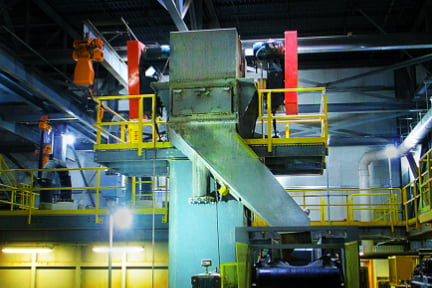Regardless of the material being handled or the configuration type being used, regular maintenance is absolutely essential to bucket elevators. In addition to preventing costly breakdowns, consistent bucket elevator maintenance provides a multitude of benefits such as improved safety and an increase in the life of the equipment. Listed below are key steps FEECO recommends following in order to properly maintain a bucket elevator.
General Safety Procedures
Above all else, safety is the most important consideration on the bucket elevator maintenance checklist. General safety considerations include the following:
- Report any equipment irregularities to the appropriate personnel and log all relevant information to the equipment’s records. Irregularities include unusual noises and odors, as well as excessive wear, damage, or malfunction.
- Ensure all guards are installed and in good shape.
- Never operate equipment if worn, damaged, or malfunctioning components are present.
- Always follow manufacturer recommended adjustment procedures to avoid premature damage or wear.
- Record all inspections, maintenance, lubrications, and adjustments. Records should include the date, supplies used, condition of each component, and a signature from the person who performed the bucket elevator maintenance.
- Shutdown, lockout, and tag all machine controls before performing any inspection, maintenance, lubrication, or adjustment.
Maintenance and Lubrication Procedures
Regular cleaning should be performed to ensure material build-up is continually removed. It is especially important to clean out the boot after each use if the elevator is used seasonally. The equipment should also be operated for a short period of time every two weeks to ensure belt flexibility is maintained.
Additionally, the following bucket elevator maintenance and lubrication procedures are recommended:
Bearings
There are four lubrication points on FEECO bucket elevators: two head bearings and two boot take-up bearings. Each lubrication point must be serviced at least once a week under normal operating conditions. Recommended bearing lubricants are based on standard operating temperatures and can be found in the bucket elevator equipment manual. Refer to the manufacturer’s recommended maintenance and lubrication procedures for more information.
Chain and Sprocket Drive
Although the chain drive is splash lubricated, the chain drive’s oil level must be checked at the start of each operating shift. This can be visually monitored using the sight gauge (located on the side of the drive guard). If the oil level is low, fill the supply to the required level. Refer to the bucket elevator manual for lubricant recommendations.
Periodically inspect the oil for signs of contaminants. Drain, flush, and refill the oil supply if contaminants are present. Additionally, the chain should be soaked in a nonflammable solution to remove particles, dirt, or water from inside the bushings, rollers, and sidebars. The sprockets should also be cleaned. Both the chain and sprockets should be dried using compressed air. Replace either component if the chain or sprockets show signs of excessive wear or damage.
Belt Drive
- Check belts for wear, replace if worn.
- Check belts for proper tension. Tighten if they are too loose and loosen if they are too tight.
Additional Component Maintenance
Refer to the manufacturer’s recommended maintenance and lubrication procedures for the following components:
- Speed Reducer and Couplings
- Drive Motor
Inspection Procedures
Regular bucket elevator maintenance should include periodic inspections of the following:
Belt:
Ensure that the bucket elevator belt is centered on the head and boot pulleys.
Chain:
Make sure chain is not worn or damaged.
Buckets:
Straighten misaligned buckets and replace damaged buckets as necessary.
Chain and Sprocket Drive:
Periodically inspect the sprockets and drive chain for signs of wear or damage. The best way to effectively examine the component is to remove the upper drive guard and slowly rotate the sprockets and chain to inspect the component for issues.
The sprocket alignment, shaft alignment, and chain slack should also be checked to ensure the proper drive alignment is being maintained. Refer to the bucket elevator manual for more information on this procedure.
Drive System:
Inspect this component for worn, misaligned, or loose chains (belts).
Electrical Wiring, Contacts, Switches, etc.:
Ensure that all electrical components are in good condition.
Nuts and Bolts:
Ensure that all nuts and bolts are properly tightened.
Vertical Position:
Periodically check the bucket elevator for vertical position. (Make sure elevator structure is not leaning.
Maintain Proper Operation Procedures
In addition to regular maintenance, proper bucket elevator operation procedures must also be followed. Therefore, bucket elevators should only be operated by trained personnel. Operator training is available through FEECO’s comprehensive customer service support team.
FEECO is proud to have an exceptional service team with decades of experience solving and preventing problems… even if the equipment isn’t ours! Whether a customer requires parts, installation, maintenance, or training, FEECO is prepared to support our customers 24/7. For more information on bucket elevator maintenance or any other of our other equipment services, contact FEECO today!

